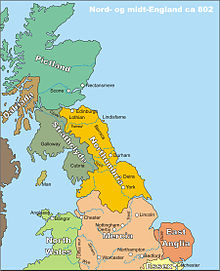Northumbria
Northumbria (also Northhumbria, Northumbria, Norþhymbra Rīce ) was one of the Anglo-Saxon small kingdoms of England during the Heptarchy . It was created in 604 by the union of Deira and Bernicia and lasted until it was conquered by Danish Vikings in 867 .
history
It was named for its location north of the Humber River . Along with Mercia and East Anglia , it was the third founding of the Angles' empire . The name Humber is etymologically derived from the Latin noun umbra for "shadow" or the verb umbro for "to shade / cover" and obviously refers to the dark or black color of the estuary water .
Unification of the empire
The independent kingdoms of Bernicia and Deira were first united by Æthelfrith of Bernicia around 604. He was killed in 616 in the Battle of the Idle River by Rædwald , who succeeded Edwin , son of Ælle von Deira. After Edwin's death in 633, Bernicia and Deira briefly became independent empires again. In 634, after only a year of independence, Oswald reunited Northumbria, but with his death in 642 it was divided again. Oswald's brother Oswiu ruled only in Bernicia until 651, but was then able to set up dependent sub-kings in Deira. King Ecgfrith (664 / 670-685) finally established in 679 the final unit of Northumbria.
hegemony
In the 7th century Northumbria reached its greatest extent. The British kingdoms of Elmet (616), Craven (around 675) and Dent (?) Were incorporated into Northumbria. Edwin's (616–633) sphere of influence included the Isle of Man and Anglesey . Temporarily exercised kings like Oswald (634-642) as Bretwalda a supremacy over the Picts , Scots , the Kingdom of Strathclyde and Anglo-Saxon kingdoms of. Northumbria's most important adversary in the 7th century was the Anglo-Saxon Mercia. With the battle of Dunnichen Mere in 685, in which the Northumbrian king Ecgfrith fell, the Northumbrian hegemony in the north and the influence on the south ended.
Decline
The 8th century was marked by disputes for the throne and feuds between rival families. Of the 14 kings who ruled between 705 and 806, four were murdered, six deposed and banished to a monastery or exile, and two abdicated and voluntarily went to the monastery. Only King Eadberht (737-758) was able to gain some areas in what is now Ayrshire (Scotland) and Strathclyde. King Eanred (810? –840/841) had to submit to Egbert von Wessex in 829 and Northumbria was subject to tribute .
The Viking Age began in 793 with an attack on Lindisfarne Monastery . Numerous other raids followed in the summers, and from 850 the Vikings wintered in England. In 867, after the conquest of York by the great pagan army of the Danish Vikings and the establishment of the kingdom of Jórvík , the southern part of Deira was incorporated into the Danelag . For the northern part of the kingdom of Bernicia, the Vikings appointed the local king Ecgberht I as sub-king. After his fall in 872, his Anglo-Saxon successor, Ricsige , tried to rebuild Northumbria, but was pushed back to Bernicia in 874/875. Around 878, the Danish Vikings also conquered the former Bernicia, which was then completely absorbed into the Kingdom of Jorvik. In the north, Ealdred (913–927) submitted to the English king Æthelstan (924–939) in 927 . The English King Eadred (946–955) was able to drive out the last Danish King Erik the Blood Ax in 954 , thus completing the reconquest of Northumbria. From this point on, the local rulers were first Ealdormen and then Earls .
Northumbria remained a disputed territory, now between England and Scotland . Only with the Treaty of York in 1237 was membership of England finally regulated.
Northumbria today
Today Northumbria usually refers to a slightly smaller region that corresponds to the counties of Northumberland and County Durham in north-east England. This region, officially called North East England , contains the Newcastle upon Tyne metropolitan area . Newcastle is also the largest location for Northumbria University (or University of Northumbria at Newcastle), one of the great younger universities in Northern England.
Northumbria, in the modern sense, has its own traditions that cannot be found anywhere else in England, e.g. B. the rapper sword chain sword dance, block dances and a special kind of bagpipes called Northumbrian smallpipes .
See also
swell
- Beda Venerabilis : Historia ecclesiastica gentis Anglorum , Online in the Medieval Sourcebook (English)
literature
- Robert Colls (Ed.): Northumbria. History and Identity, 547-2000 . Phillimore, Chichester 2007, ISBN 978-1-86077-471-3 .
- NJ Higham: The Kingdom of Northumbria. AD 350-1100 . Sutton, Stroud 1993, ISBN 0-86299-730-5 .
- David Rollason: Northumbria. 500-1100. Creation and Destruction of a Kingdom . Cambridge University Press, Cambridge u. a. 2003, ISBN 0-521-81335-2 .
- Michael Lapidge, John Blair, Simon Keynes, Donald Scragg (Eds.): The Blackwell Encyclopaedia of Anglo-Saxon England. Wiley-Blackwell, Oxford et al. a. 2001, ISBN 978-0-6312-2492-1
Web links
- Northumberland (English)
- Northumbrian Pipers' Society (English)
- Northumbria University (English)
